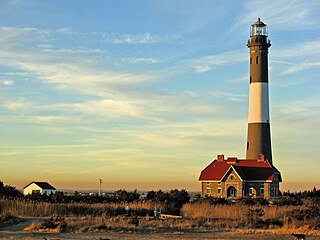
The Fire Island Lighthouse is a visible landmark on the Great South Bay, in southern Suffolk County, New York on the western end of Fire Island, a barrier island off the southern coast of Long Island. The lighthouse is located within Fire Island National Seashore and just to the east of Robert Moses State Park. It is part of the Fire Island Light Station which contains the light, keepers quarters, the lens building containing the original first-order Fresnel lens, and a boat house.

Saugerties Light, known also as the Saugerties Lighthouse, is a lighthouse on the Hudson River north of Saugerties, New York.

Warwick Light, also known as Warwick Lighthouse, is an historic lighthouse in Warwick, Rhode Island.

The Squirrel Meadow Guard Station is a ranger station in the backcountry of Targhee National Forest in Wyoming. The original facility was established in 1907, with the present structures built in 1934. The log cabin station is an example of a standard US Forest Service backcountry patrol structure.

The Huckleberry Mountain Fire Overlook is a fire lookout station in northern Bridger-Teton National Forest. The rustic two-story log structure was built in 1938 by the Civilian Conservation Corps to a standard U.S. Forest Service design. The lookout was used for fire surveillance until 1957.

The Logging Creek Ranger Station is the oldest continually operating administrative site in Glacier National Park. The rustic log cabin is an early example of what would become a typical style of western park structure. The district includes a cabin used as a residence for the summer fire guard.

The Polebridge Ranger Station in Glacier National Park was the first administrative area in the park, predating the park's establishment. The ranger station was destroyed by fire, leaving the residence.

The Kishenehn Ranger Station in Glacier National Park was originally built in 1913, but a fire burned it down in 1919. They rebuilt it in 1921. Located nearly five miles south of the Canada–United States border, the log cabin was one of the earliest administrative structures in the park. The cabin was designed in an early version of what became the National Park Service Rustic style.

The Belly River Ranger Station Historic District in Glacier National Park includes several historic structures, including the original ranger station, now used as a barn. The rustic log structures were built beginning in 1912. Other buildings include a woodshed, built in 1927 to standard National Park Service plans and a cabin used as a fire cache.

The Kintla Lake Ranger Station in Glacier National Park is a rustic log structure that was built by the Butte Oil Company in 1900 at Kintla Lake. It was taken over by the National Park Service and used as a ranger station. It is significant as a remnant of early oil exploration activities in the Glacier area. A boathouse was built by the National Park Service in 1935 to the same design as the boathouses at Upper Lake McDonald and Saint Mary ranger stations. A fire cache cabin, identical to those at Logging Creek, Polebridge and Lake McDonald ranger stations was built in 1934.

The Allison Ranger Station is a Forest Service compound consisting of eight rustic buildings located in the Malheur National Forest in the Ochoco Mountains of eastern Oregon. It was originally built as a district ranger station for the Snow Mountain Ranger District. It was later converted to a summer guard station. Today, it is an active Forest Service guard station with a crew of twelve fire fighters on station during the summer fire season. The ranger station's oldest building, the Donnelly Cabin, is currently listed on the National Register of Historic Places. Most of the other buildings at the Allison Ranger Station are eligible for historic designation, but are not yet listed on the national register.

The Upper Sandy Guard Station Cabin is a log and stone building built in 1935. It was funded as part of the Federal work relief Emergency Relief Appropriations Act of that year, and also by funds from the City of Portland, Oregon.
Architects of the United States Forest Service are credited with the design of many buildings and other structures in National Forests. Some of these are listed on the National Register of Historic Places due to the significance of their architecture. A number of these architectural works are attributed to architectural groups within the Forest Service rather than to any individual architect. Architecture groups or sections were formed within engineering divisions of many of the regional offices of the Forest Service and developed regional styles.

The Cedar Guard Station No. 1019 in the Rogue River – Siskiyou National Forest, near Cave Junction, Oregon, was built in 1933 by the Civilian Conservation Corps. It was listed on the National Register of Historic Places in 1986 for its architecture. It was designed by Forest Service architects in rustic style. The listing included two contributing buildings, a single dwelling and a garage, on a 10-acre (4.0 ha) area.

The Cima Park Fire Guard Station near Douglas, Arizona was built in 1934 by the Civilian Conservation Corps. It was listed on the National Register of Historic Places in 1993 for its architecture, which is "vernacular, log" architecture. It was designed by the USDA Forest Service and served as institutional housing. The listing included four contributing buildings on a 2-acre (0.81 ha) area.

The Elkhorn Guard Station, also known as the Elkhorn Ranger Station, comprises four buildings in the backcountry of Olympic National Park, Washington. The station was built by the U.S. Forest Service between 1930 and 1934, before the establishment of the national park, when the lands were part of Olympic National Forest (USFS). The structures were designed in the Forest Service's interpretation of the National Park Service rustic style, using native materials and construction techniques. The complex was built using labor from the Public Works Administration and the Civilian Conservation Corps. The Elkhorn Guard Station is one of five surviving USFS-built guard stations.

The Billy Meadows Guard Station is a Forest Service Guard Station located in the Wallowa–Whitman National Forest near Joseph, Oregon, USA. In addition to the main residence, the station also includes a garage, warehouse, barn, and oil and gas house. The residence has a rustic design; the exterior walls use shiplap to resemble a log cabin, and the gabled front porch is supported by two logs. The original gable roof was wood shingled to fit the rustic theme but has since been replaced with sheet metal. The Civilian Conservation Corps built the guard station during the Great Depression.

The Jack Creek Guard Station is a ranger patrol cabin in Medicine Bow National Forest in Carbon County, Wyoming. The one-room log cabin was built by U.S. Forest Service district ranger Evan John Williams in 1933-34. It was built to Forest Service Plan A-4, featuring half-dovetailed corners and a deep front porch with a gabled wood shake roof. A stove is vented through a brick chimney at the back of the cabin.

The Carey Dome Fire Lookout is a fire lookout tower complex located in Nez Perce National Forest, 9 miles north of United States Forest Service Burgdorf Guard Station, near Burgdorf in Idaho County, Idaho. It was listed on the National Register of Historic Places in 1994.

The Chamberlain Ranger Station Historic District, also known as the Chamberlain Guard Station, is located in the Frank Church-River of No Return Wilderness within Payette National Forest in Idaho County, Idaho. It was listed on the National Register of Historic Places in 2004.




















